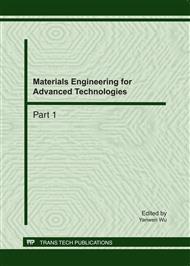p.347
p.352
p.357
p.363
p.369
p.375
p.381
p.387
p.393
Trasmittance Self-Oscillating Behavior of a Non-Thermoresponsive Polymer Chain Induced by the Belouzov-Zhabotinsky (BZ) Reaction
Abstract:
In this study, the influence of the temperature on the transmittance self-oscillation of a non-thermoresponsive polymer chain was investigated. The polymer chain was composed of a biocompatible and non-thermoresponsive poly-vinylpyrrolidone (PVP) main-chain covalently-bonded to the 10 wt% ruthenium catalyst moiety (Ru(bpy)3) of the BZ reaction. As a result, the amplitude of the transmittance self-oscillation slightly decreased with the increase in the temperature. The period of the transmittance self-oscillation decreased with increasing the temperature in accordance with the Arrenius equation. Therefore, the period of the self-oscillation can be controlled by the selection of the temperature.
Info:
Periodical:
Pages:
369-374
Citation:
Online since:
June 2011
Authors:
Keywords:
Price:
Сopyright:
© 2011 Trans Tech Publications Ltd. All Rights Reserved
Share:
Citation:


